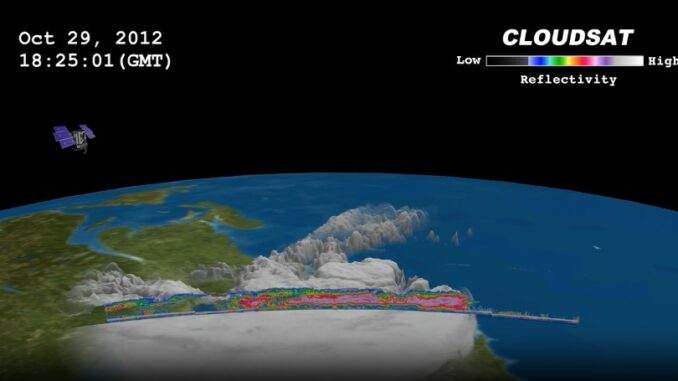
Editor’s note: Matthew Rogers was the education and public outreach lead for the CloudSat mission until 2011. Today he works at the Cooperative Institute for Research in the Atmosphere at CSU. SOURCE asked him to write about this historic event.
On April 28, 2006 at 4:02 a.m., a NASA rocket carrying the CSU-led CloudSat mission lifted off from Vandenberg Air Force Base in California.
Onboard the spacecraft was the Cloud Profiling Radar (CPR), a never-before-flown instrument capable of detecting the most subtle details of clouds. After two months stabilizing of the instrument in its orbit, which took the spacecraft from pole to pole in around 90 minutes, CloudSat turned on its unique radar for what was planned to be a 22-month mission studying the structure of the Earth’s clouds.
On Wednesday, December 20, 17 years and eight months later, that radar will be turned off for the last time.
A vision of University Distinguished Professor Emeritus Graeme Stephens (now the director of Satellite Climate Studies at NASA’s Jet Propulsion Laboratory), CloudSat was designed to answer lingering questions about the role of clouds in the Earth’s atmosphere, water and energy systems. How does a changing climate impact the kind and distribution of clouds around the planet? How do clouds absorb, emit and redirect the energies of the sun and the Earth? What are the critical properties inside clouds that cause aircraft icing, or hinder tropical storm development, or myriad other questions for which we had no observations to answer?

To answer those questions, we needed to peer into the very hearts of the clouds. We needed a special kind of radar, far more sensitive than the ones used to detect storms and rainfall here on the surface. And we needed it to fly in space so that every cloud could be observed. No other mission flown by NASA had proposed such a task, and whether or not such a radar could even be flown was an open question.
That question was answered by a remarkable mission lasting far beyond the hopes of any of its engineers. Data collected by the CPR has been used in hundreds of publications, and the observations and knowledge gained has led to thousands more. At CSU, more than a dozen M.S. and Ph.D. degrees have been minted using CloudSat data, forging academic careers and spreading the influence of the University. As part of an outreach program of the mission, students looked to the skies as the satellite flew overhead – taking photos of clouds, to be matched with the data from the spacecraft, and maybe inspiring dreams of science and engineering as well.
After suffering several battery issues and spacecraft malfunctions – well over a decade from when the mission was planned to end – the ability of the spacecraft to take regular observations was at last thwarted. The satellite moved from its orbit for the safety of other missions, and this week, with the shutdown of the radar, the data collection phase of the mission will end. Early in 2024, the spacecraft will be deorbited, marking the final end of a truly remarkable mission.
But not the science, according to the mission’s founder. “The science never ends,” said Stephens, speaking to his science team last week.
And with nearly two decades of data stored here at CSU, there are more mysteries about the nature of clouds to be unraveled by the legacy of this remarkable instrument, and the science of CloudSat will live on yet longer.
Support Northern Colorado Journalism
Show your support for North Forty News by helping us produce more content. It's a kind and simple gesture that will help us continue to bring more content to you.
BONUS - Donors get a link in their receipt to sign up for our once-per-week instant text messaging alert. Get your e-copy of North Forty News the moment it is released!
Click to Donate
